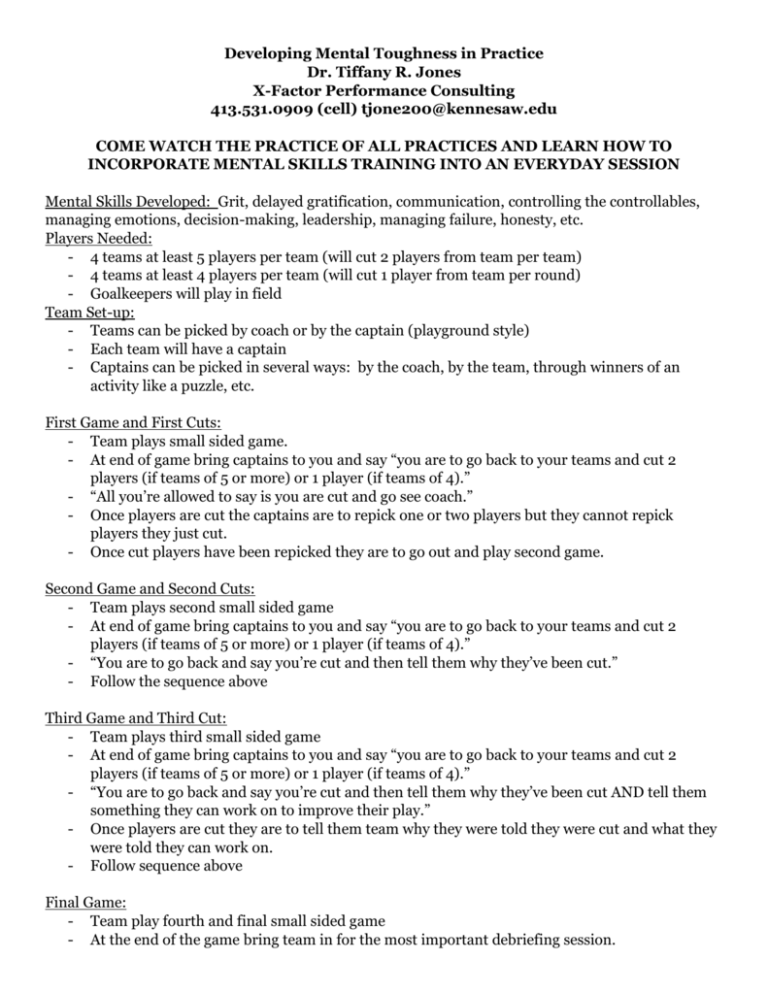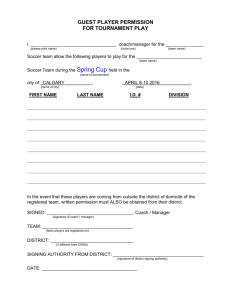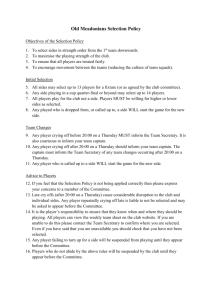Dr. Tiffany Jones - Developing Mental Toughness in
advertisement

Developing Mental Toughness in Practice Dr. Tiffany R. Jones X-Factor Performance Consulting 413.531.0909 (cell) tjone200@kennesaw.edu COME WATCH THE PRACTICE OF ALL PRACTICES AND LEARN HOW TO INCORPORATE MENTAL SKILLS TRAINING INTO AN EVERYDAY SESSION Mental Skills Developed: Grit, delayed gratification, communication, controlling the controllables, managing emotions, decision-making, leadership, managing failure, honesty, etc. Players Needed: - 4 teams at least 5 players per team (will cut 2 players from team per team) - 4 teams at least 4 players per team (will cut 1 player from team per round) - Goalkeepers will play in field Team Set-up: - Teams can be picked by coach or by the captain (playground style) - Each team will have a captain - Captains can be picked in several ways: by the coach, by the team, through winners of an activity like a puzzle, etc. First Game and First Cuts: - Team plays small sided game. - At end of game bring captains to you and say “you are to go back to your teams and cut 2 players (if teams of 5 or more) or 1 player (if teams of 4).” - “All you’re allowed to say is you are cut and go see coach.” - Once players are cut the captains are to repick one or two players but they cannot repick players they just cut. - Once cut players have been repicked they are to go out and play second game. Second Game and Second Cuts: - Team plays second small sided game - At end of game bring captains to you and say “you are to go back to your teams and cut 2 players (if teams of 5 or more) or 1 player (if teams of 4).” - “You are to go back and say you’re cut and then tell them why they’ve been cut.” - Follow the sequence above Third Game and Third Cut: - Team plays third small sided game - At end of game bring captains to you and say “you are to go back to your teams and cut 2 players (if teams of 5 or more) or 1 player (if teams of 4).” - “You are to go back and say you’re cut and then tell them why they’ve been cut AND tell them something they can work on to improve their play.” - Once players are cut they are to tell them team why they were told they were cut and what they were told they can work on. - Follow sequence above Final Game: - Team play fourth and final small sided game - At the end of the game bring team in for the most important debriefing session. Developing Mental Toughness Out of Practice Dr. Tiffany R. Jones X-Factor Performance Consulting 413.531.0909 (cell) tjone200@kennesaw.edu IF YOU WATCHED THE ON FIELD SESSION LEARN THE “NOW WHAT” AND EVEN IF YOU DIDN’T SEE THE ON FIELD SESSION LEARN HOW TO TEACH GRIT AND DELAYED GRATICFICATION – THE KEYS TO SUCCESS ON AND OFF THE FIELD Debriefing: - As a coach begin asking questions. - Try to be very patient; silence in the beginning is normal - Based upon observations can ask players specific questions - At the end of the debriefing section make sure you summarize the themes, concepts, ideas that came from the session - Set 2-3 goals for the team based on what they learned through session (i.e. we are going to communicate in a positive manner; we’re going to focus on positive body language when we’re under pressure). Example questions for debriefing: Captains: 1. What was the most difficult part of being a captain and why? 2. Would you make different decisions why or why not? 3. Would you want to be captain again moving forward why or why not? Players cut: 1. Do you think you should have been cut why or why not? 2. Did you think the reasons you were given were valid why or why not? 3. How did it feel to be cut, why? 4. Would you have made different decisions if you had been captain, why or why not? Players never cut: 1. Do you think your captain made good choices or did a good job, why or why not? 2. Would you have made different decisions, why or why not? What would you have done differently? 3. How did it feel watching your teammates being cut, why? 4. How did your team play differently after cuts were made? Why do you think there were differences? Other Tidbits for Coaches: 1. Observation will be key for you. Watch how captains behave with teammates (body language and communication). 2. Watch how cut players respond and how noncut players respond to teammates being cut. 3. Do captains do exactly what you tell them to do….why or why not? 4. Is there a change in play after players start getting cut? 5. You can put consequences on losing team (ie. Burpees). This may put pressure on teams to make decisions that lead to winning/focus on results.







